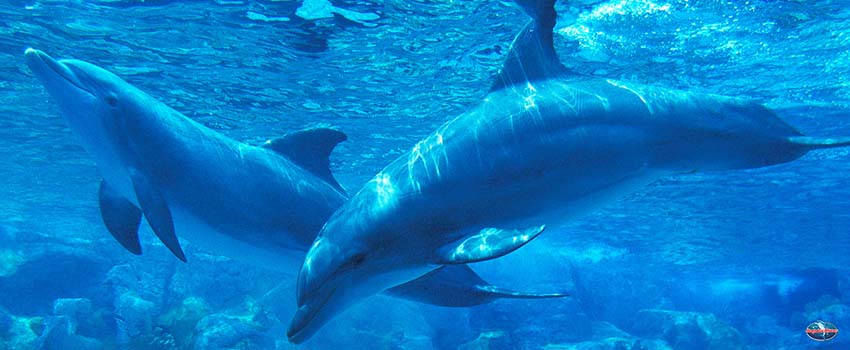For dolphins, communication is key. Whether hunting a school of fish or coordinating a pod through John’s Pass, understanding each other is a top priority. Unlike humans, dolphins communicate through a series of whistles and clicks. Each sound is as unique as any word in the English language. Dolphin communication sounds reflect names, places, and even their state of mind. However, researchers remain in the dark about many of their meanings.
So, why do dolphins whistle? The answer is as complex as the act itself.
Friends and Family
According to the most recent research, a dolphin’s language is both extensive and elaborate. Much of what we know involves a ‘signature whistle.’ This whistle works much in the same way as humans giving each other names. Mothers and their calves often share a whistle that is unique to them, and bonded pairs give each other whistles to identify each other. Dolphins even learn the signature whistle of casual acquaintances.
Bottlenose dolphins give themselves signature whistles as well. This acts like a name and can identify where a dolphin is while underwater. Sound travels up to five times faster underwater than it does in the air. And for dolphins, sound is the primary form of communication. This can include yelps if a dolphin is courting a partner or squeaking when danger is around.
When a dolphin is born, the mother will give the calf a unique name. This not only allows for staying close and creates a dolphin connection between the pair. The calf will keep the unique sound as its name into adulthood.
A Complicated System
Dolphins don’t produce sound in the same way that we do. Humans produce sound by pushing air through the larynx that exits through the mouth. On the other hand, dolphins produce sounds through the nasal passage. The “phonic lips” of the dorsal bursa send vibrations through tissue along the nasal passage, creating whistles, squeaks, clicks, and yelps.
Clicking is one of many dolphin communication sounds you also need to learn about. Because there are not one but two of these dorsal bursae, a dolphin can simultaneously create both clicks and whistles. Of course, a dolphin must be able to hear, right? The speedy dolphin’s sleek body is designed to move fast underwater; thus, a human-like ear would only slow them down. So, how do dolphins hear?
Through their jawbone!
While underwater, a dolphin’s jawbone conducts sound to its ears. Small openings on either side of their head can hear outside the water, but underwater, they are airtight. A dolphin’s jawbone acts as a receiver, transmitting sound via pulses to its inner ear. If this sounds like a dolphin may not be able to hear well, think again. A human can hear sounds ranging from 20 Hz to 20 kHz, while dolphins can hear between 20 Hz and 150 kHz.
These fun facts about dolphins help us appreciate these impressive creatures we love to see up close.
Getting Around via Echolocation
Believe it or not, dolphins have spectacular eyesight. When spy hopping or flipping into the air, a dolphin can take a peek at humans aboard boats or spot potential danger. A dolphin peering at a human may interpret them as a threat or pass harsh judgment on an outfit. Underwater, a dolphin can see well, too, though conditions may mean needing to rely on echolocation, their preferred way of getting around.
Echolocation is a form of discovering the world around you through using sound. Clicking or whistling noises bounce off of objects either near or far. The time it takes for the sound to bounce back determines the distance. Bats, hedgehogs, and whales use echolocation. Humans can use it too; for instance, Marve’s Daredevil is known to use echolocation while fighting crime.
Underwater, echolocation is one of the most vital dolphin communication sounds. Unlike in the open air, the sea can be murky and clouded with dust particles or other debris. Using eyesight in these conditions can prove useless. With echolocation, dolphins can find food, danger, and each other even in unsettled waters. In other words, a dolphin can navigate a dark room ripe with hazards using only its voice.
For communicating, whistles do the trick. Echolocation relies on clicking and rattling sounds.
Do Dolphins Have Accents?
Learning about dolphins and how they interact can teach us more about their complex lifestyle. Like humans, where a dolphin lives can influence how they communicate. Accents in humans vary from place to place, and recent science has determined a similar influence on dolphins.
In a recent article by the Smithsonian Magazine, researchers claim to have discovered regionality in dolphin communication. Researchers studied 188 hours of recorded dolphin whistles and clicks in the Mediterranean sea. They found that the pitch, tone, and length of signature whistles varied in six distinct pods.
While not as jarring as a southern drawl or a posh English accent, a signature whistle can reflect a dolphin’s home turf. Dolphins living in areas with plenty of sea grass produced shorter whistles with a higher pitch. Where the sea bottom was muddy, dolphins created deeper and longer whistles. The size of a dolphin’s community determined the whistle’s style. Smaller populations produced unique whistling, while larger populations had fewer differences.
Human traffic from boats and other underwater activities may affect dolphin communication sounds; these often change in areas with higher human activity.
A Universal Language
Communication is the key to being as successful as a dolphin. A dolphin connection begins the moment a calf is born. Signature whistles are as unique as snowflakes or thumbprints. A dolphin can use its whistle to survive, whether in clear blue waters or a turbulent sea. These interesting facts only strengthen a dolphin’s allure.
Come listen to dolphin sounds today.
Get up close and personal with the bottlenose dolphins of Boca Ciega Bay aboard the best dolphin cruise in Madeira Beach. Dolphin Quest and Shark Boat Eco-educational tours depart daily from John’s Pass in St. Petersburg, Florida. We’ll take you to see dolphins, listen to their calls, and witness their spectacular jumps while appreciating the beauty of nature.
Adventure awaits; call us today!











